32 Shrubs and Trees with Purple Berries – Identification Guide (With Pictures)
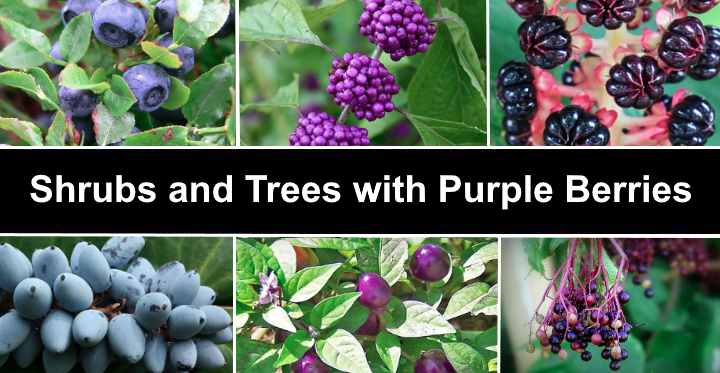
Trees and shrubs with purple berries can add a pop of color to your garden. Shrubs with purple berries like beautyberry, chokeberry, and viburnum are ideal for adding color and texture to a garden landscape. Also, trees with purple berries, like the American elderberry and serviceberry trees, add shade, beautiful flowers, and privacy to your front or backyard. Purple berries contrast with lush green foliage, providing stunning visual interest for your landscape.
Planting shrubs and trees with purple berries adds a touch of elegance and uniqueness to your garden or backyard. They provide interesting colors, attract wildlife, and are a food source for many birds. With so many options available, it’s important to identify types of shrubs and trees that produce purple berries.
This article is an identifying guide to trees and shrubs that bear purple berries. Pictures and descriptions of small and large ornamental landscaping plants will help you decide on the best options for your garden.
Purple Berry Identification
To identify purple berries on shrubs and trees, observe the plant’s growth characteristics. Distinct identification features like leaf shape, type of flowers, mature size, and the arrangement of berries can help distinguish tree and shrub species. Also, pictures of shrubs and trees with purple berries can help with identification.
Why It’s Important to Identify Shrubs and Trees with Purple Berries
It’s really important to know which trees and shrubs have purple berries. Some of them have purple berries that are safe and tasty to eat right off the plant. But others, like black nightshade and pokeweed, have dangerous purple berries that are poisonous. So, always make sure you know what kind of purple berry you’re dealing with before eating any from the wild.
Shrubs with Purple Berries
Here is a list of eye-catching ornamental shrubs with purple berries.
Beautyberry Shrubs (Callicarpa)

Beautyberry plants are sun-loving deciduous shrubs that produce clusters of vibrant purple berries in fall and winter. The highly ornamental berries grow in groups spaced out along the arching stems. These berries contrast with the elliptical green leaves that turn yellow in the fall. Beautyberry blooms in early summer with white, violet, or pink flowers.
Fast-growing beautyberry shrubs grow up to 6 ft. (1.8 m) tall in full sun. The attractive purple-fruit shrubs perform well as foundation plantings, specimen plants, or for adding color and texture to the back of shrub borders. Their attractive flowers attract pollinators, and the bright purple berries attract birds to gardens.
Some varieties of beautyberry shrubs, like Callicarpa dichotoma f. albifructa, produce showy clusters of white berries.
Here are several varieties of beautyberry shrubs prized for their vivid displays of purple berries on show from late summer through winter:
American Beautyberry (Callicarpa Americana): This deciduous shrub is native to the United States. It grows 3 to 4 ft. (0.9 – 1.2 m) tall and produces clusters of brightly-colored lilac-purple berries from late summer. The shrub has cascading or weeping branches, adding to its ornamental appeal.
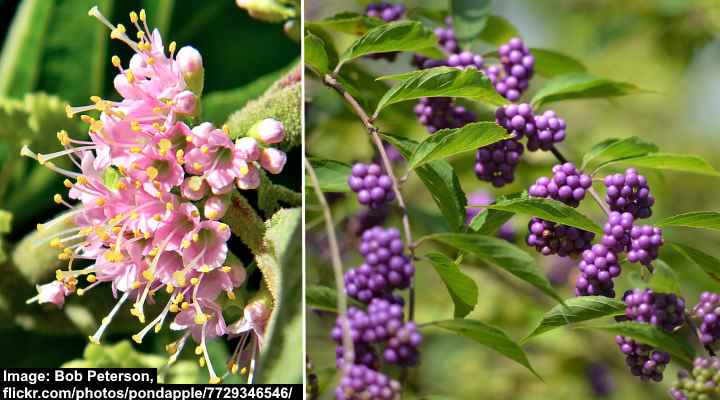
American Beautyberry (Callicarpa americana)
Velvet Leaf Shrub (Callicarpa pedunculata): This ornamental purple-fruiting shrub is known for its dark green, velvety leaves, pale pink or purple flowers growing above the leaf axil, and clusters of deep purple berries in the late summer and fall. The large shrub or small tree grows up to 13 ft. (4 m) tall.
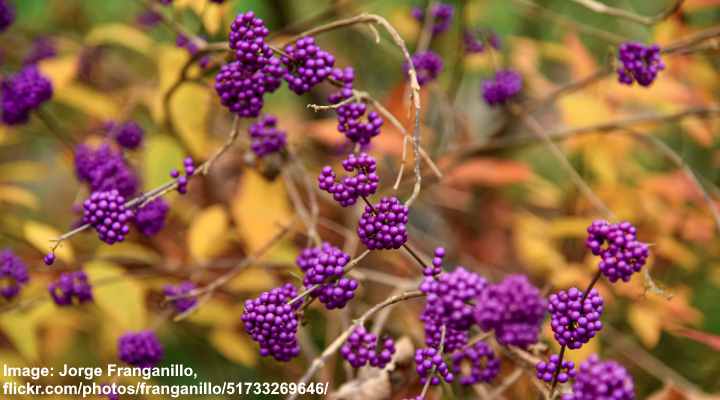
Velvet Leaf Shrub (Callicarpa pedunculata)
Bodinier’s Beautyberry (Callicarpa bodinieri): Prized for its vibrant, glossy violet-purple berries, this deciduous bush blooms in summer with small lilac flowers. The purple fruits on arching branches resemble beads on a string, appearing in late summer and persisting through winter. The sun-loving shrub grows 4 to 6 ft. (1.2 – 1.8 m) tall and wide.
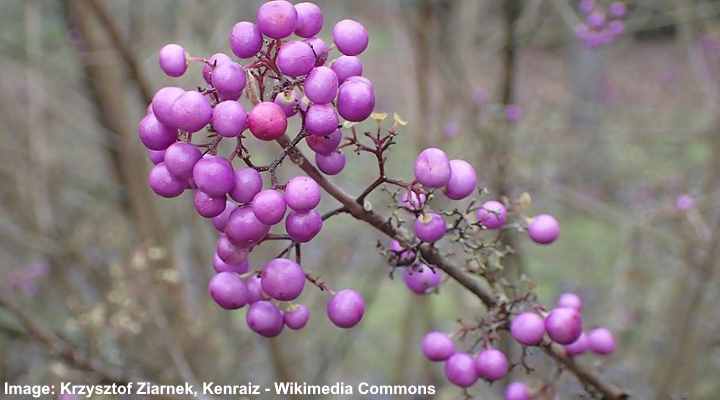
Bodinier’s Beautyberry (Callicarpa bodinieri)
Purple beautyberry (Callicarpa dichotoma): The purple beautyberry is an invasive shrub with purple berries. The small pink to lavender fruits ripen in the late summer and early fall and last through winter. In the fall, the lush green foliage turns golden yellow, adding to its ornamental appeal. The small shrub grows 3 to 4 ft. (0.9 – 1.2 m) tall and up to 5 ft. (1.5 m) wide. Callicarpa dichotoma ‘Early Amethyst’ is a cultivar with purple berries that ripen earlier before other beautyberry shrubs.
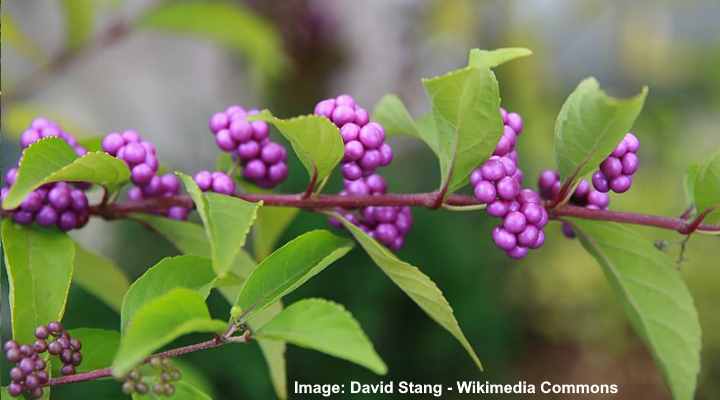
Callicarpa dichotoma ‘Early Amethyst’
Issai Beautyberry (Callicarpa dichotoma ‘Issai’): Native to Japan, Korea, and China, this small to medium-sized deciduous shrub is prized in landscapes for its unusual clusters of bright purple berries. The drought-tolerant shrub grows up to 4 ft. (1.2 m) tall and 5 ft. (1.5 m) wide. It’s ideal as a deciduous hedge, foundation planting, or container plant.
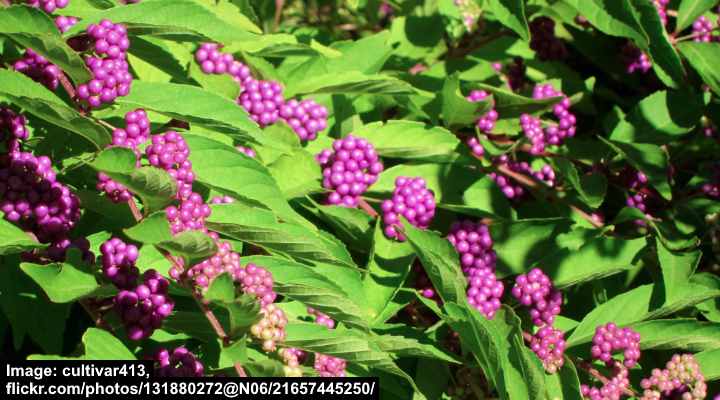
Issai Beautyberry (Callicarpa dichotoma ‘Issai’)
- USDA Planting Zones: 5 to 8
- Sunlight: Full sun to partial shade
- Mature Size: 2 to 6 ft. (0.6 – 1.8 m) tall and wide, depending on the species
Chokeberry (Aronia spp.)

Chokeberry is a white-flowering shrub producing clusters of small dark purple to black berries in the fall. Chokeberry shrubs are identified by their clusters of white, five-petalled flowers, glossy green, elliptic leaves, and purple fruits. The shrub’s fall foliage is red or purple, making it stand out in landscapes.
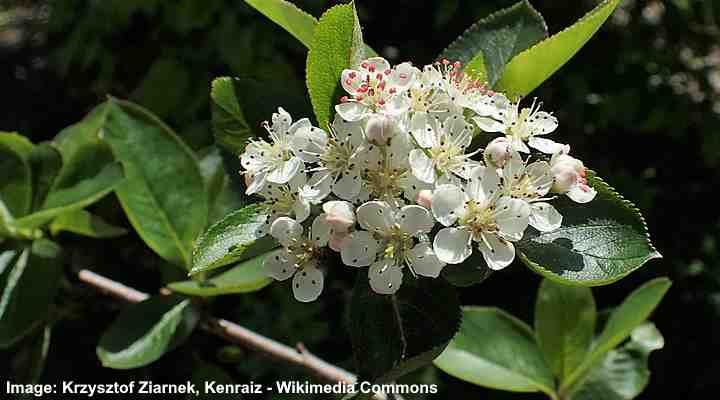
Flowers of black chokeberry (Aronia melanocarpa)
Chokeberry shrubs grow up to 6 ft. (1.8 m) tall and wide. Their suckering nature means they quickly form dense thickets. The purple berries are known for their tart to bitter taste. While the berries are edible, they are so astringent they are too bitter to consume raw. Typical uses for the edible purple berries are for making jams, jellies, and juices.
Hardy purple-fruiting chokeberry shrubs perform well in wet conditions and are ideal for rain gardens. You can also plant them in groups or mass in shrub borders.
- USDA Planting Zones: 3 to 8
- Sunlight: Full sun to partial shade
- Mature Size: 3 to 6 ft. (0.9 – 1.8 m) tall and wide
Prickly Heath (Gaultheria mucronata)

Two prickly heath cultivars— ‘Mulberry Wine’ and ‘Rosea’–are evergreen shrubs with purple berries. Not growing taller than 5 ft. (1.5 m), the prickly shrub features small, glossy, dark green leaves with pointed tips, white, bell-shaped flowers, and berries in various pink or purple shades.
Prickly heath is a compact shrub that thrives in full shade to partial shade and acidic soils. This low-growing shrub is a good landscaping option for ground cover, rock gardens, and low-maintenance shaded borders. Prickly Heath is also deer-resistant and drought-tolerant.
When considering eating prickly heath berries, exercise caution. Some sources say they’re safe and tasty when ripe, but others warn they might be toxic in large amounts. Due to mixed expert opinions, it’s best not to eat these berries unless their safety is confirmed. Always consult with botanical experts if in doubt.
- USDA Planting Zones: 7 to 9
- Sunlight: Partial shade to full shade
- Mature Size: 3 to 5 ft. (0.9 – 1.5 m) tall and wide
Coralberry (Symphoricarpos orbiculatus)

Coralberry is a deciduous bushy plant with pinkish to purple berries growing on arching stems. The shrub adds a burst of color to landscapes with its dark green leaves, bell-shaped pink or white flowers, and abundant clusters of purple berries. The vibrant berries persist into winter, adding visual interest to the gardens, and are vital food for birds.
Growing up to 5 ft. (1.5 m) tall, coralberry is an easy-grow, drought-tolerant shrub that thrives on neglect. The versatile shrub is useful in foundation plantings, mixed shrub borders, and tall ground cover. It also performs well in shade gardens as an informal hedge.
In addition to its tolerance for full shade, hardy coralberry shrubs are resistant to deer browsing, clay soil, and dry shade.
- USDA Planting Zones: 2 to 7
- Sunlight: Full sun, partial shade, deep shade
- Mature Size: 2 to 5 ft. (0.6 to 1.5 m) tall and 4 to 8 ft. (1.2 – 2.4 m) wide
Oregon Grape (Mahonia aquifolium)
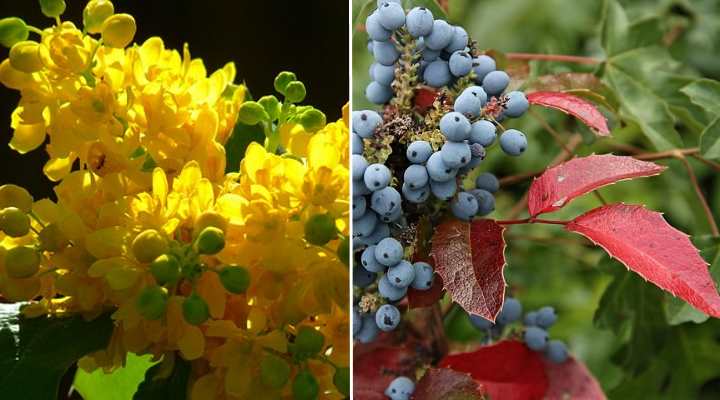
Also called holly-leaved barberry, Oregon grape is an evergreen shrub with dark bluish-purple berries. The shrub has shiny, holly-like leaves with spiky edges, clusters of fragrant, bright golden-yellow spring flowers, and edible berries resembling bunches of grapes. The evergreen leaves emerge bronze-red in spring and turn deep burgundy in fall.
Oregon grape shrubs grow up to 6 ft. (1.8 m) tall. They thrive in areas with little direct sunlight, ideal for shaded gardens. The attractive yellow flowers attract pollinators, and the purple grape-like berries are food for birds and other wildlife.
Landscaping ideas for Oregon grape shrubs include foundation plantings, shade borders, and native plant gardens. Also, its edible, tart purple berries are ideal for making jams and jellies.
- USDA Planting Zones: 5 to 8
- Sunlight: Partial shade to heavy shade
- Mature Size: 3 to 6 ft. (0.9 to 1.8 m) tall and 2 to 5 ft. (0.6 – 1.5 m)
Darwin’s Barberry Shrub (Berberis darwinii)

Darwin’s barberry shrub is an orange-flowering bushy plant with blue, deep red, or purple berries. This thorny evergreen shrub features leathery, holly-like dark green prickly leaves and clusters of small, bright yellow or orange flowers in late winter or early spring. The showy flowers give way to deep purple berries that cover the bush in summer and fall.
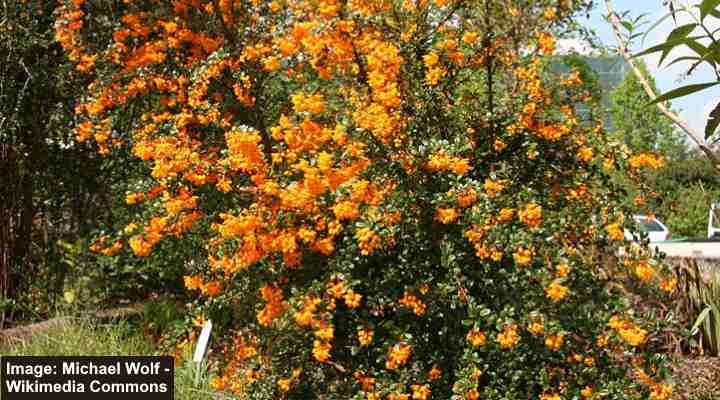
Darwin’s barberry shrub
Darwin’s barberry shrub grows up to 10 ft. (3 m) tall and wide. It grows rapidly and requires little maintenance in a sunny or partially shaded garden. Its dense growth habit and jaggy leaves are ideal for hedges, security borders, privacy screens, and planting around property boundaries.
- USDA Planting Zones: 7 to 10
- Sunlight: Full sun to partial shade
- Mature Size: 5 to 10 ft. (1.5 – 3 m) tall and wide
Viburnum Shrubs
Viburnum shrubs are a diverse group of bushy plants known for their showy berries, many of which are purple shades. Ornamental features of viburnum shrubs include flat-topped clusters of white flowers, glossy green or golden-yellow leaves, and deep blue berry-like drupes in late summer and fall.
The easy-to-grow shrubs adapt to different soil conditions, making them a popular choice for many gardens. They range in height from small compact shrubs a few feet tall to larger trees growing 20 ft. (6 m) or taller.
Here is a list of viburnum shrubs that produce eye-catching purple berries:
Laurustinus (Viburnum tinus): This vigorous evergreen shrub has colorful metallic blue or purple berries, fragrant white flowers, and a rounded, upright habit. Growing up to 12 ft. (3.6 m) tall, it is a good evergreen, deer-resistant shrub for planting as a hedge, screen, or along a foundation line.
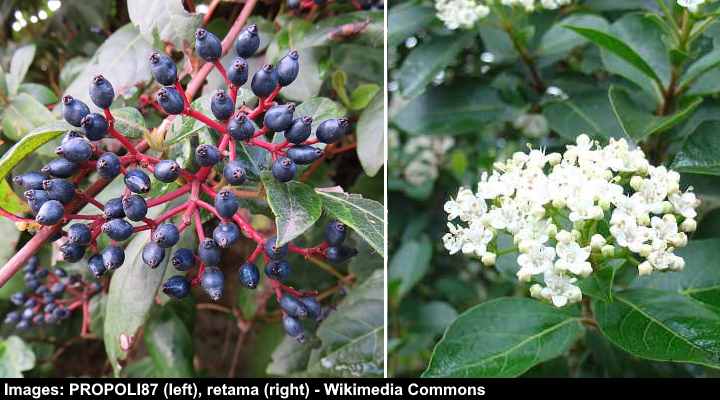
Laurustinus (Viburnum tinus)
Arrowwood Viburnum (Viburnum dentatum): This multi-stemmed deciduous shrub blooms in late spring with showy flat-topped clusters of creamy-white flowers. Clusters of purple-blackish berries follow the white flowers, contrasting with the lustrous dark green leaves. Landscaping uses for arrowwood viburnum include a hedge, screening bush, or stand-alone specimen plant. It grows up to 10 ft. (3 m) tall.
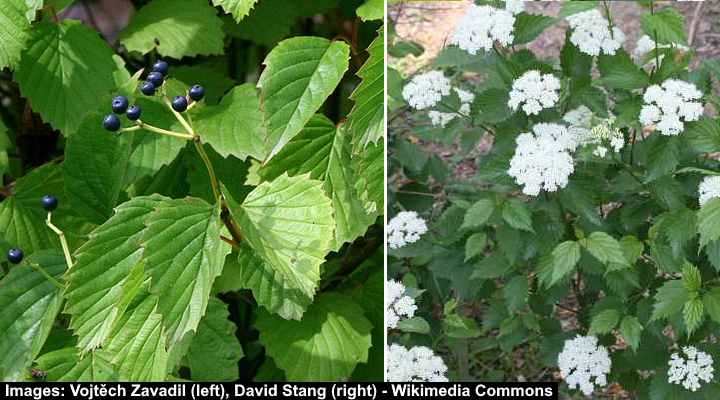
Arrowwood Viburnum (Viburnum dentatum)
Withe Rod (Viburnum nudum): Also called smooth witherod, the shrub is prized for its stunning display of deep wine-red and purple berries in the fall. The large shrub has shiny oval leaves and flat-topped clusters of creamy-white flowers up to 5” (13 cm) wide. Its tolerance for soggy soil makes it ideal for rain gardens or planting near ponds or streams.
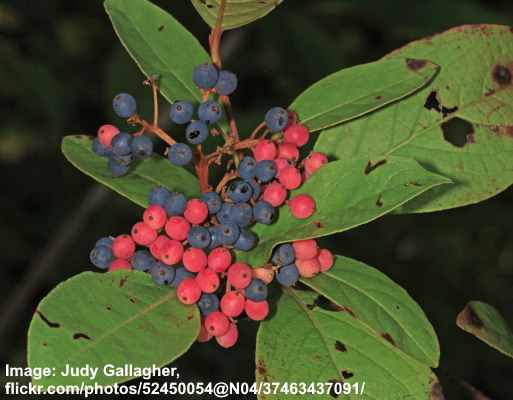
Withe Rod (Viburnum nudum)
David Viburnum (Viburnum davidii): This small, compact, ornamental shrub features bluish-black to purple berries, clusters of small, white, star-shaped blooms, and leathery, dark green leaves. This landscaping shrub grows 3 to 5 ft. (0.9 – 1.5 m) tall and wide.
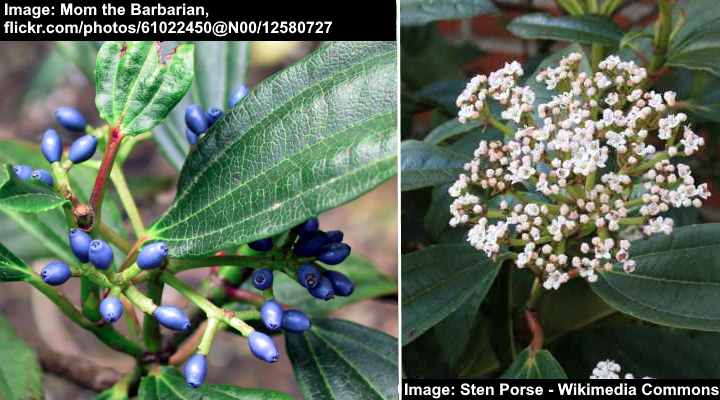
David Viburnum (Viburnum davidii)
- USDA Planting Zones: 3 to 8
- Sunlight: Full sun or partial shade
- Mature Size: 1 to 20 ft. (0.3 – 6 m) tall and wide, depending on the variety
Serviceberry Shrubs (Amelanchier spp.)
Serviceberry shrubs are shade-tolerant deciduous shrubs with attractive black, blue, deep red, or purple edible berries. Ornamental features of the shrubs are their multi-trunked, rounded habit, oval-shaped green leaves, and drooping clusters of white or pinkish spring flowers. The shrubs’ fall colors are orange, golden-yellow, and burgundy.
Serviceberry shrubs typically grow up to 6 ft. (1.8 m) tall and adapt well to various growing conditions. You can plant serviceberry shrubs along a foundation line, flowering hedge, screen, or specimen plant. With their beautiful flowers, attractive dark purple berries, and vibrant fall foliage, serviceberry shrubs are popular for adding natural beauty to landscapes.
Here is a list of serviceberry shrubs that produce purple berries:
Mountain Serviceberry (Amelanchier bartramiana): This deciduous shrub is native to the southeastern United States. It produces purple-black berry-like fruits 0.5” (13 mm) long. It blooms in spring with star-shaped, white flowers. The shrub grows up to 10 ft. (3 m) tall.
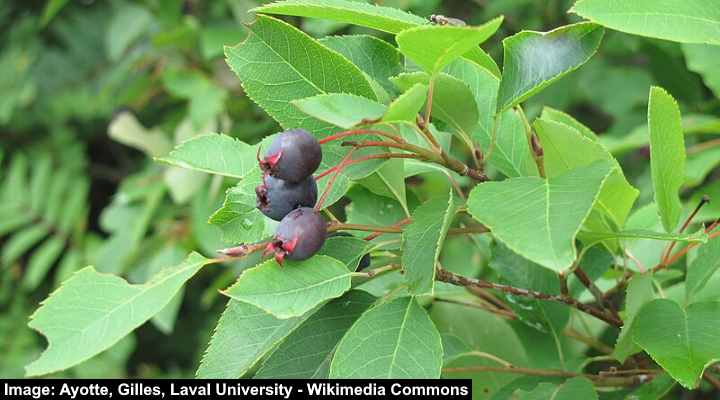
Mountain Serviceberry (Amelanchier bartramiana)
Saskatoon Serviceberry (Amelanchier alnifolia): Also called juneberry, the deciduous shrub produces delicious edible blue or purplish-black berries. It blooms in spring with small five-petalled flowers, and its green foliage turns yellow or red in the fall. The shrub grows 10 to 15 ft. (3 – 4.5 m) tall and wide.
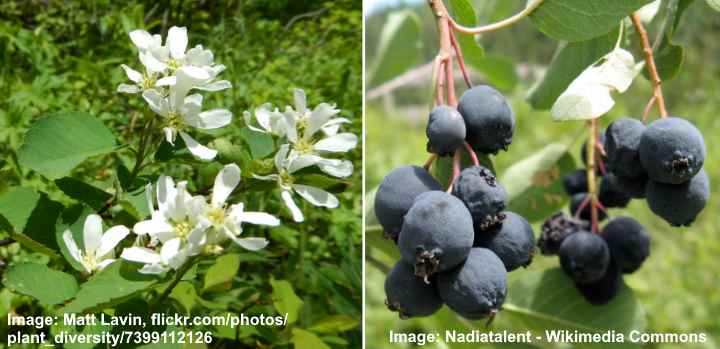
Saskatoon Serviceberry (Amelanchier alnifolia)
Dwarf Serviceberry Shrub (Amelanchier spicata): This bushy plant is a multi-stemmed shrub with purple or lavender berry-like pomes. The fleshy fruits start dark red and mature to purple-black. The lush green leaves turn orange or golden yellow in the fall. The dwarf compact shrub grows 3 to 5 ft. (0.9 – 1.5 m) tall and wide.
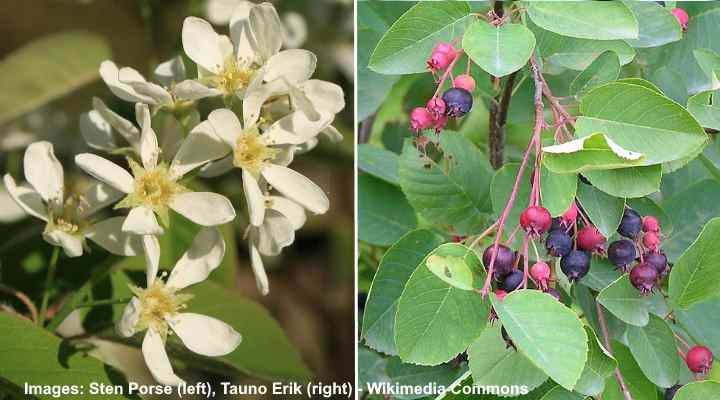
Dwarf Serviceberry Shrub (Amelanchier spicata)
Utah Serviceberry Shrub (Amelanchier utahensis): This shrub or small purple-berry-producing tree blooms in spring with showy white flowers and contrasting green leaves growing on gray branches. In summer and fall, dark purple berry-like pomes appear. It’s drought-tolerant once established and attracts birds, butterflies, and bees to native flower gardens.
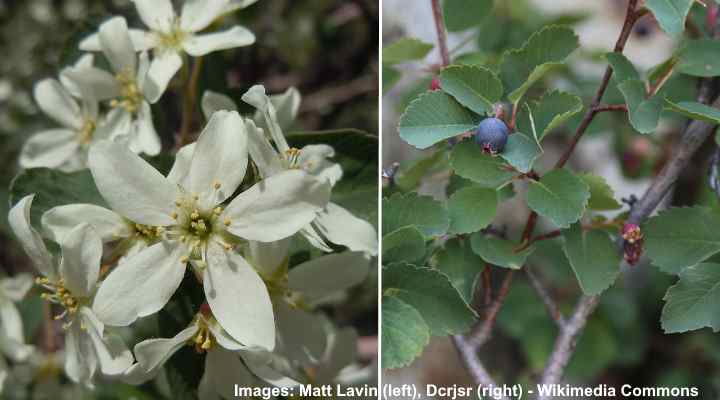
Utah Serviceberry Shrub (Amelanchier utahensis)
- USDA Planting Zones: 4 to 8
- Sunlight: Full sun to partial shade
- Mature Size: Ranges from 3 to 6 ft. (0.9 to 1.8 m) tall and wide, depending on the species
Virginia Creeper (Parthenocissus quinquefolia)

Virginia creeper is a colorful deciduous vine producing fleshy, round, dark purple berries in the fall. This vigorous, fast-growing climbing plant has maple-like leaves that turn crimson red and burgundy in the fall. The dense foliage usually covers the greenish-white flowers and bluish-black fruits. The berries are visible after the leaves drop.
Virginia creeper is a versatile, fast-growing vine that grows in direct sunlight or deep shade up to 50 ft. (15 m) tall. You can plant the climbing vine to grow as a screen or to cover walls or fences. Its sticky tendrils grow over arbors, pergolas, and unsightly garden structures.
You can also let the drought-tolerant, shade-happy vine grow as ground cover.
- USDA Planting Zone: 3 to 11
- Sunlight: Full sun, partial shade, or full shade
- Mature Size: 30 to 50 ft. (9 – 15 m) tall and up to 10 ft. (3 m)
Gooseberry (Ribes uva-crispa)

Gooseberry plants are deciduous fruit-producing shrubs with small, tart purple berries or currants. The small shrubs grow up to 5 ft. (1.5 m) tall. They typically have a round shape, multiple spiny branches, and deeply serrated leaves with three to five lobes. Gooseberry shrubs produce small, inconspicuous flowers that give way to tasty berries.
Small gooseberry shrubs are hardy and adaptable, thriving in most soil types. Landscaping uses for gooseberry shrubs include fruit gardens, foundation planting, or a security barrier, thanks to its sharp thorns. Pruning in winter and summer maximizes berry production.
- USDA Planting Zones: 4 to 6
- Sunlight: Full sun to partial shade
- Mature Size: 2 to 5 ft. (0.5 to 1.5 m) tall and wide
Blackcurrant (Ribes nigrum)

Blackcurrant is known for its bunches of dark purple to glossy black berries or currants in summer. This winter-hardy fruit-producing shrub features five palmate, dark green lobed leaves, small clusters of pinkish flowers, and abundant purplish-black berries. Blackcurrant shrubs grow up to 5 ft. (1.5 m) tall and wide.
Blackcurrant plants prefer full sun to partial shade and well-draining, damp soil. They are relatively low-maintenance shrubs to grow for their delicious berries. However, you can plant blackcurrant shrubs as a living fence, hedgerow, or garden divider. They also perform well in containers to attract butterflies, bees, and birds.
- USDA Planting Zones: 3 to 7
- Sunlight: Full sun to partial shade
- Mature Size: 5 ft. (1.5 m) tall and wide
Blueberry (Vaccinium corymbosum or Vaccinium angustifolium)

Blueberry deciduous shrubs are small, bushy plants producing sweet and tasty clusters of juicy, purplish-blue berries and dark green leaves. This shrub features white or pink bell-shaped flowers in the spring, small oval leaves, and low growth. In winter, reddish-bronze twigs provide aesthetic interest.
Two popular varieties of blueberry shrubs are lowbush blueberry (Vaccinium angustifolium) and highbush blueberry (Vaccinium corymbosum).
Lowbush blueberry (Vaccinium angustifolium): Not growing taller than two feet tall (0.6 m), this purple-berry-producing shrub has lustrous foliage that turns bronze and scarlet in fall. You can plant it in mixed shrub borders or grow it as ground cover.
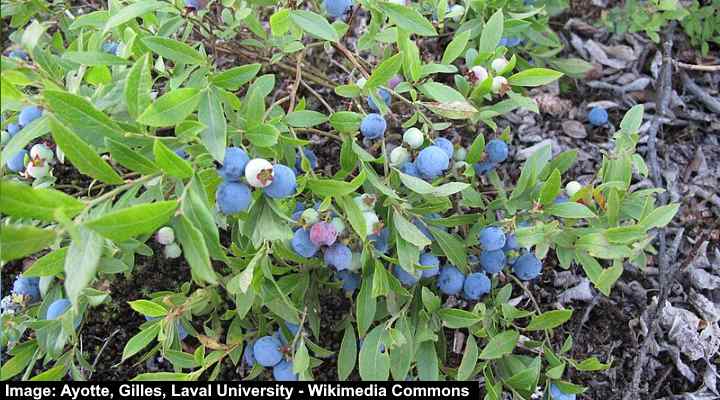
Lowbush blueberry (Vaccinium angustifolium)
Highbush blueberry (Vaccinium corymbosum): This upright, deciduous shrub grows up to 8 feet (2.4 m) tall and wide. It has light blue to purple berries that ripen in mid-summer. Landscaping ideas for highbush blueberries include mixed shrubs, low-growing hedges, or container plants.
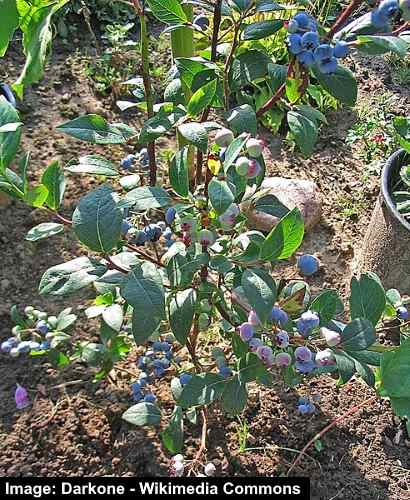
Highbush blueberry (Vaccinium corymbosum)
- USDA Planting Zones: 2 to 8, depending on the cultivar
- Sunlight: Full sun to partial shade
- Mature Size: 2 to 8 ft. (0.6 – 2.4 m) tall and wide, depending on the variety
Bilberry (Vaccinium myrtillus)
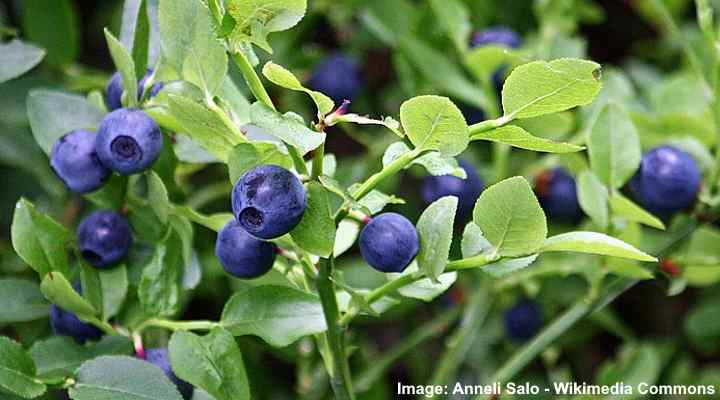
Bilberry shrubs produce small, dark blue to purple berries and don’t grow taller than two feet tall (60 cm). Native to Northern Europe, fruit-producing bilberry shrubs have small, oval-shaped leaves on reddish stems. The shrubs bloom in spring with bell-shaped, whitish flowers that develop into dark purple to black berries.
Bilberry shrubs have a low, creeping habit, forming dense mats of foliage. The shrubby plants prefer partial to full shade and are commonly found in woodland areas. Landscaping ideas for bilberry shrubs include wildlife gardens, ground cover with white flowers and purple berries, and rock gardens. They also thrive in containers.
- USDA Planting Zone: 2 to 8
- Sunlight: Partial shade to full shade
- Mature Size: Up to 2 ft. (0.6 m) tall with a spreading habit
Spiked Blackthorn (Prunus spinosa)
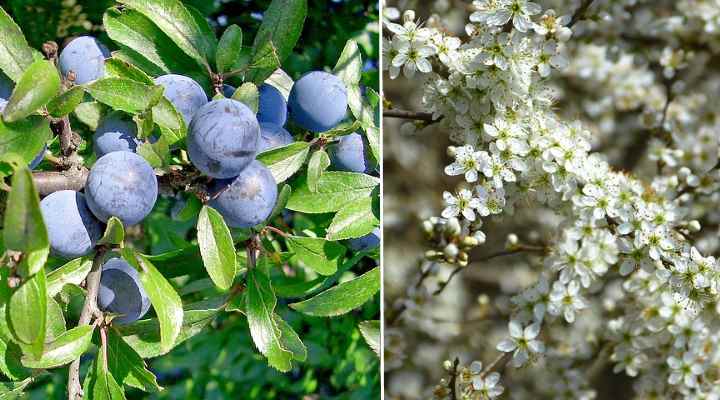
Spiked blackthorn is a fruit-producing deciduous shrub or small tree, identified by rounded purple berries growing in dense clusters. Features of the thorny shrub are its spine-covered branches, oval leaves, creamy-white, five-petalled flowers, and dark purple or black fruits that look like blueberries. The purplish berries are called sloes in Europe and have a sharp, tangy taste.
Spiked blackthorn shrubs grow up to 16 ft. (5 m) tall. Its stiff, spiny branches create dense thickets, making the purple-berry shrub ideal for hedgerows, privacy screens, and windbreaks. The hardy shrub tolerates a range of soil conditions and is ideal for its ornamental value and wildlife appeal.
- USDA Planting Zone: 4 to 8
- Sunlight: Full sun to partial shade
- Mature Size: 16 ft. (5 m) tall and wide
Black Nightshade (Solanum nigrum)

Also called blackberry nightshade, this dense, erect shrub has very dark purple to black globular berries appearing in summer. Identifying features of the nightshade plant are its tiny star-shaped white flowers with five petals, green leaves, and berry-like dark purple-black fruits. The flowering stalks have umbel-like clusters with up to 23 white flowers.
Black nightshade doesn’t grow taller than 4 ft. (1.2 m) tall. Although it’s not traditionally used as an ornamental shrub, it has aesthetic features. Its creamy-white flowers contrast with attractive dark green leaves followed by purplish-black berries.
Notably, common or European black nightshade (Solanum nigrum) is less toxic than the deadly nightshade (Atropa belladonna) variety. The purple berries of common nightshade grow in clusters rather than individually like deadly nightshade.
- USDA Planting Zones: 10 and 11
- Sunlight: Full sun
- Mature Size: 1 to 4 ft. (0.3 – 1.2 m) tall
Pokeweed (Phytolacca)
Pokeweed is a weedy, perennial, shrubby plant with vibrant purple berries that are poisonous. The vigorous shrubs can grow aggressively, choking out other ornamental plants and shrubs. The identifying features of the purple-berry shrub are its attractive reddish stems, bright green leaves, showy white flower clusters, and purple fruit appearing in late summer and fall.
American pokeweed (Phytolacca americana) is a spreading, herbaceous perennial that grows like a bush. It has a long blooming period, with its white flowers lasting from late summer to late winter. Its large lanceolate leaves emit an unpleasant aroma when crushed. It grows 4 to 10 ft. (1.2 – 3 m) tall and up to 5 ft. (1.5 m) wide.

American pokeweed (Phytolacca americana)
Indian pokeweed (Phytolacca acinosa) is a non-native bushy plant with showy flowering spikes and dark purple to black berries. The glossy black fruits contrast with the bright red stems. This invasive shrub with purple berries grows 3 to 6.5 m (0.9 – 2 m) tall.

Indian pokeweed (Phytolacca acinosa)
What should you do if you touch pokeweed? The poisonous plant contains toxins that may cause skin irritation. Therefore, you should wash the affected area immediately with soap and water. Avoid rubbing your eyes and face. Applying calamine lotion can help calm irritation and redness.
- USDA Planting Zone: 4 to 8
- Sunlight: Full sun to partial shade
- Mature Size: 4 to 10 ft. (1.2 – 3 m) tall and 2 to 3 ft. (0.6 – 0.9 m) wide
Trees with Purple Berries
Here is a list of deciduous and evergreen ornamental trees with purple berries.
American Elderberry (Sambucus canadensis)
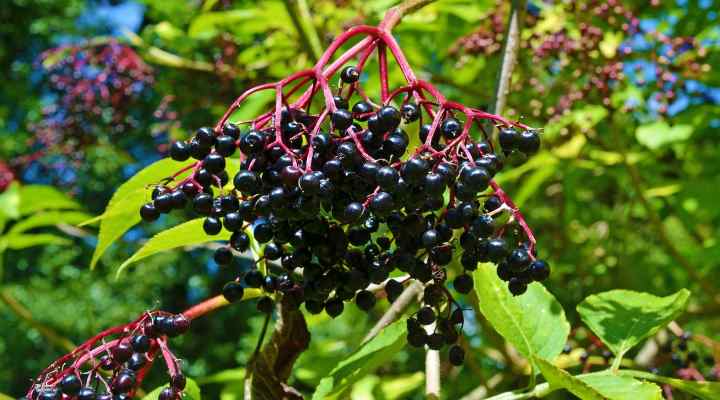
The American elderberry is a woody shrub or small tree with abundant drooping clusters of dark purple to black berries in the late summer and early fall. Identifying features of the shrub-like tree are its small white flowers in umbrella-like clusters, bright green compound leaves, and round, berry-like drupes. The American elderberry grows up to 12 ft. (3.6 m) tall.

American elderberry shrubby tree and flowers
American elderberry showy blooms appear in spring and summer, followed by its glossy dark berries. In the fall, the tree’s attractive foliage turns a vibrant golden yellow. The flowers attract pollinators in summer, and the tree’s berries are a favorite food source for birds and wildlife.
This small tree is ideal for planting as a focal point, hedge, privacy barrier, or specimen tree. The flowers on the shrub’s spreading, rounded branches bloom profusely in at least six hours of sunlight daily.
- USDA Planting Zone: 4 to 8
- Sunlight: Full sun to partial shade
- Mature Size: 5 to 12 ft. (1.5 – 3.6 m) tall and wide
Eastern Red Cedar (Juniperus virginiana)

Eastern red cedar is a coniferous, conical tree that drops dark purple-blue berry-like cones in fall and winter. This evergreen tree is characterized by its scale-like blue-green or gray-green foliage and juicy, seed-containing waxy cones. The tree grows up to 50 ft. (15 m) tall and has a pyramidal shape with dense foliage.
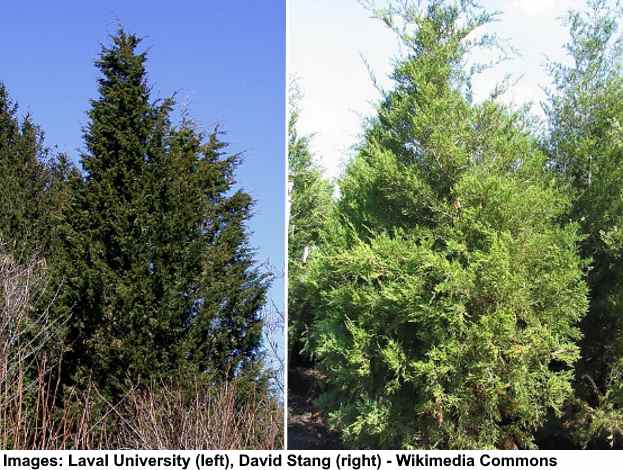
Eastern red cedar trees
Eastern red cedar is a heat, drought, and cold-tolerant tree. Thriving in full sun, it performs well in cold landscapes, retaining its dark green color throughout the year. Although they look like purple berries, the trees’ fleshy cones are a valuable food source for birds.
Landscape uses for this slow-growing juniper variety include a windbreak, privacy screen, or specimen plant.
- USDA Planting Zones: 2 to 10
- Sunlight: Full sun
- Mature Size: 40 to 50 ft. (12 to 15 m) tall and 8 to 20 ft. (2.4 to 6 m) wide
Eastern Red Mulberry (Morus rubra)
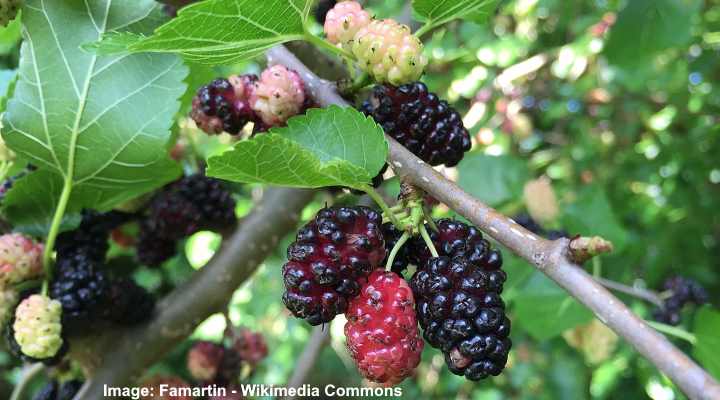
Eastern red mulberry is famed in North America for producing sweet, juicy, dark reddish-purple berries. This fast-growing tree features serrated, dark green, heart-shaped leaves and inconspicuous green or yellow flowers. The purple drupes look like blackberries and are only edible when ripe. The sweet fruits are used for making jams, jellies, and wine.
Eastern red mulberry grows up to 60 ft. (18 m) tall. It’s characterized by its rounded crown of dense foliage, spreading habit, and rapid growth. The berries are ready for consumption between June and August when the fruit has no green hues.
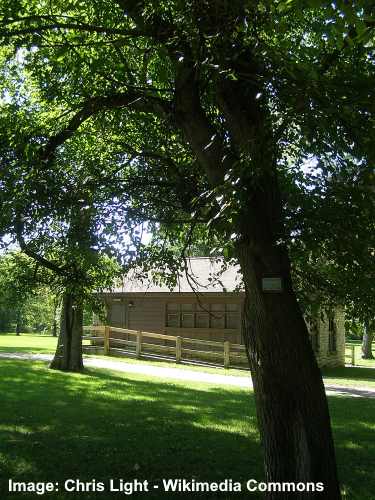
Red mulberry tree
Unfortunately, the dark purple berries of the eastern red mulberry tree can create a mess when they fall. However, it’s a popular landscaping tree to create shade in gardens.
- USDA Planting Zones: 4 to 10
- Sunlight: Full sun to partial shade
- Mature Size: 30 to 50 ft. (9 – 15 m) tall and up to 40 ft. (12 m) wide
Paperbark Satinash (Syzygium papyraceum)

Paperbark satinash is an evergreen tree native to Australia that produces large purple berry-like fruits. Attractive features of the tropical tree are its papery, reddish-brown peeling bark, glossy, dark green leathery leaves, and clusters of pinkish-purple spring flowers. The tree provides a lush, tropical look to landscapes in warm climates.
Growing up to 65 ft. (20 m) tall, paperbark satinash has a dense, pyramidal shape. It grows well as an evergreen privacy hedge, tall screen, or shade tree. Its tolerance to salt spray makes it ideal for planting in sandy soils in coastal landscapes.
- USDA Planting Zones: 10 to 11
- Sunlight: Full sun to partial shade
- Mature Size: 40 to 65 ft. (12 – 20 meters) tall and wide
Serviceberry Trees (Amelanchier)
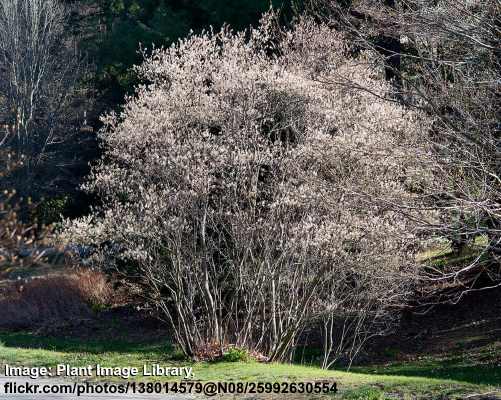
Shadblow Serviceberry Tree (Amelanchier canadensis)
Serviceberry trees produce edible purple berries throughout summer. The small trees are recognized by their beautiful spring, star-shaped flowers, lush green leaves forming a dense canopy, and edible berries. These trees also have fall and winter interest with their brilliant orange, yellow, and red colors, and attractive branching patterns.
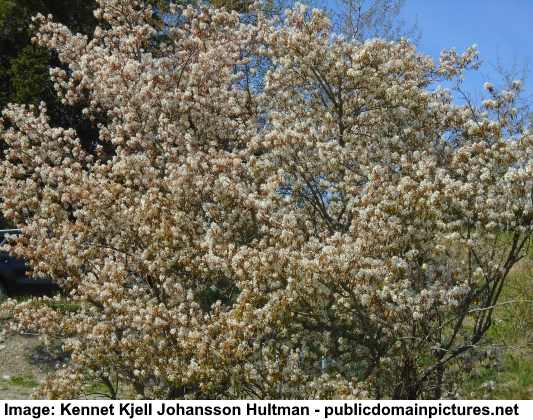
Juneberry tree (Amelanchier lamarckii)
Serviceberry trees grow up to 30 ft. (9 m) tall. The trees’ early spring blooms are vital nectar sources for bees and butterflies. Also, the clusters of rounded purple fruits drooping from the tree are vital summer food for birds.
Here are two varieties of serviceberry trees with purple berries:
Shadblow Serviceberry Tree (Amelanchier canadensis): This upright, multi-stemmed deciduous tree has edible dark purple or blue-black berries in summer. The tree grows 25 to 30 ft. (7.6 – 9 m) tall. Its leaves are oval-shaped, flowers are white in the shape of stars, and its bark is reddish brown.

Shadblow Serviceberry fruit
Juneberry (Amelanchier lamarckii): This small tree has ornamental features, including sprays of fragrant, white, starry flowers, finely toothed oval leaves, and purple-black berries. It grows in full sun or partial shade 15 to 25 ft. (4.5 – 7.6 m) tall and wide.
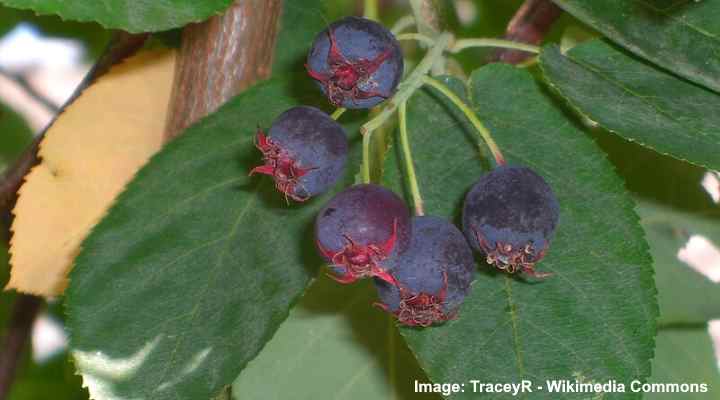
Juneberry fruit (Amelanchier lamarckii)
- USDA Planting Zones: 4 to 8
- Sunlight: Full sun to partial shade
- Mature Size: 15 to 30 ft. (4.5 to 7.5 m) tall
Common Hackberry (Celtis occidentalis)
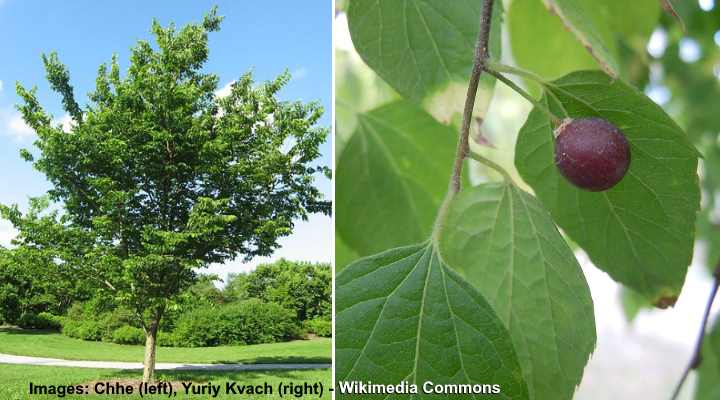
The Common hackberry is a tall deciduous tree with edible purple-dark red round berry-like drupes. The fleshy fruits appear in fall and attract birds to garden landscapes. Other identifying features are its arching branches with glossy, ovate leaves, clusters of greenish flowers, light gray bark with corky ridges, and edible berries that persist through winter.
The common hackberry tree grows up to 60 ft. (18 m) with a spreading pyramidal to rounded crown. It’s easy to grow in urban environments in full sun. It also performs well in dry soil as it’s tolerant of drought. Additionally, the ornamental tree can withstand periodic flooding. Its broad, dense canopy makes it ideal as a shade tree.
- USDA Planting Zones: 2 to 9
- Sunlight: Full sun to partial shade
- Mature Size: 40 to 60 ft. (12 to 18 m) tall and wide
Black Tupelo Tree (Nyssa sylvatica)
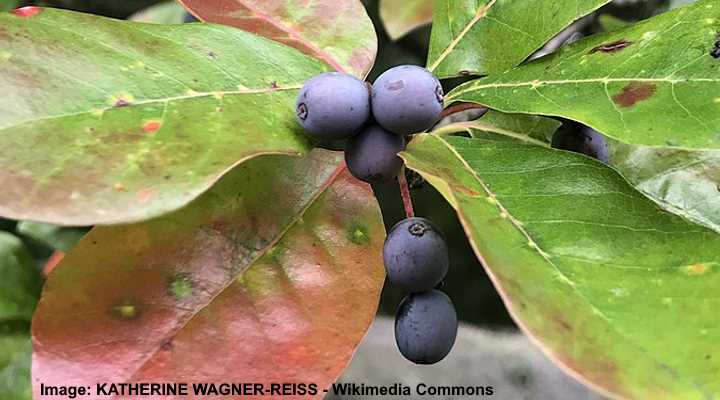
Also called the black gum tree, this ornamental shade tree produces dark purple-blackish sour fruits in late summer. The tree’s standout ornamental features are its spreading branching with a pyramidal habit, greenish-white flowers, and dark purple-blue fruits. Its dense green foliage turns spectacular orange, purple, scarlet, and gold shades in fall.
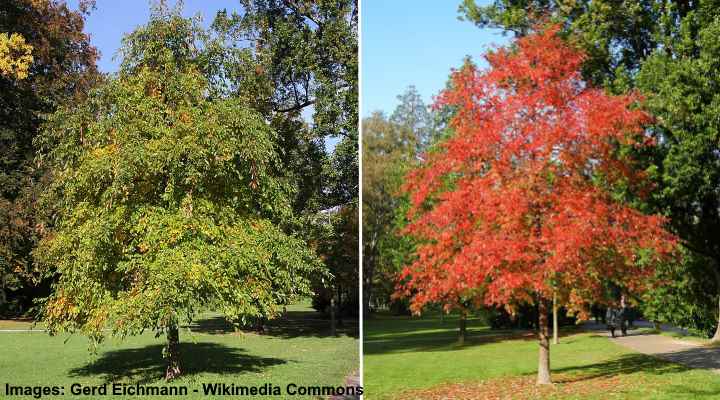
Black tupelo tree is an ornamental deciduous tree that has beautiful fall colors
The black tupelo tree grows up to 50 ft. (15 m) tall. It withstands wet soils, drought-prone ground, and full sun. It’s an ideal ornament tree for shade, and it grows in dry soils or waterlogged soils near streams and ponds.
A unique feature of the black tupelo tree is its dark gray, deeply furrowed bark. It resembles an alligator hide, adding to the purple-fruit tree’s visual interest in winter.
- USDA Planting Zones: 3 to 9
- Sunlight: Full sun to partial shade
- Mature Size: 30 to 50 ft. (9 – 15 m) tall and 20 to 30 ft. (6 – 9 m) wide
FAQs — Trees and Shrubs With Purple Berries
What invasive shrub has purple berries?
Purple beautyberry (Callicarpa dichotoma) is one of the most common purple-fruiting invasive shrubs. Native to Asia, the pink-flowering shrub with purple berries can spread uncontrollably. As an alternative, it’s best to use American beautyberry (Callicarpa americana) in landscapes in North America.
Is American Beautyberry invasive?
American Beautyberry (Callicarpa americana) is not an invasive shrub in North America. This shrub is native to the southeastern United States. It attracts native bees and butterflies to gardens and is easy to grow.
What is the bush with bright purple berries?
Beautyberry shrubs are the plants most people associate with purple berries. Most cultivars are easy to grow and provide ornamental interest throughout the year. The shrubs are characterized by clusters of pink, white, violet, or lilac flowers and vibrant purple berries.
What tree has hanging purple berries?
The American elderberry tree (Sambucus canadensis) features hanging clusters of small, purple-black berries. The elderberry fruits appear in fall after clusters of lemon-scented white flowers. The flowers and fruits attract birds, adding visual interest to landscapes.
What tree has purple berry clusters?
American beautyberry (Callicarpa americana) grows as a small tree or large shrub, producing bright purple glossy berries. The clusters of vibrant purple berries are arranged on the tree’s weeping or cascading branches. It’s a great addition to garden landscapes for adding vibrancy, texture, and year-long interest to garden landscapes.
What tree drops small purple berries?
The eastern red cedar (Juniperus virginiana) produces tiny purple berries. Although the dark blue to purple fruits look like berries, they are modified fleshy cones typical of all juniper trees. The soft berry-like fruits contain up to three seeds and are a vital food source for birds.
Related articles:
